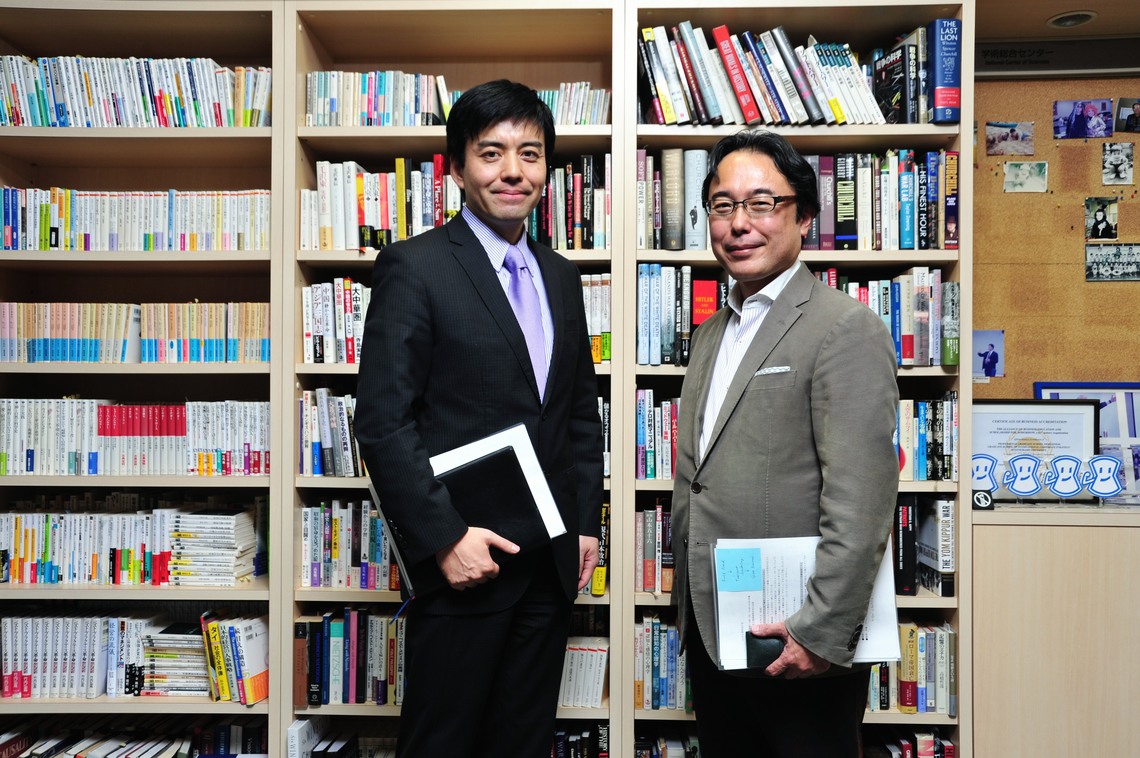「顧客主語」のマーケティングで企業や顧客に
どんな変化が起きているか
ソーシャルメディアの発達などによって、ブランドマーケティングの在り方が問われている。読み解くヒントはどこにあるのか? これからの企業成長戦略を左右するブランドマーケティングの在り方について、一橋大大学院国際企業戦略研究科教授阿久津聡さんと、電通マーケティング・デザイン・センターのコンサルティング室室長朝岡崇史さんが対談を行った。

「顧客のブランド体験をデザインする発想」
焦点の置きどころが見えづらくなってきた
朝岡: 電通のコンサルティング室は、「経営資産としてのブランディング」という立ち位置から、企業の経営者、経営企画部門の方々とお付き合いさせていただいています。最近は、問い合わせや相談の内容に変化が見られ、私の中にも新たな問題意識が生まれてきました。ブランドマーケティングの世界では、「モノ(プロダクト価値)からコト(ブランド体験価値)へ」という大きな流れがあると思うのですが、阿久津先生はこの転換をどう捉えているのでしょうか。
 阿久津: 「モノからコトへ」といわれて久しくなりますが、議論を進める前にマーケティングの観点から言葉の定義を整理してみましょう。「モノ」は言うまでもなくプロダクトで、以前はいいもの、新しいものをつくることで顧客に訴えることができました。
阿久津: 「モノからコトへ」といわれて久しくなりますが、議論を進める前にマーケティングの観点から言葉の定義を整理してみましょう。「モノ」は言うまでもなくプロダクトで、以前はいいもの、新しいものをつくることで顧客に訴えることができました。
対して、「コト」は二つのフェーズで捉えることができます。一つ目の「コト」は「個」の体験で、高級温泉リゾートで過ごす時間は、自分とリゾート、そこにある風物との調和の中で享受する体験価値です。一方、二つ目の「コト」の主体は「集団」であり、例えば「ゆるキャラ」の全国大会で、地元のキャラクターを優勝させようとする盛り上がりなど。現在のブランドマーケティングでは、この二つ目の「コト」が重視されるようになっています。
朝岡:おっしゃる通りですね。時代とともに、ブランド差別化の付加価値要素は変わってきました。プロダクト価値の時代から「個」の体験価値の時代になり、さらに「集団」の体験価値の時代になった。ソーシャルメディアの普及により企業と顧客のコラボレーション(共創)が進み、個人の体験が外に拡散しやすくなっています。
阿久津: ただ、注意しなくてはいけないのは、情報の拡散が大きくなっているのは確かですが、「個」の経験は今も依然として重要であり、「モノ」の視点も大切だということです。近年、そのバランスをうまくとることが難しくなってきており、ブランディングの焦点をどこに置くのか、見えづらくなってきたと思います。
モノは相変わらず重要、さらにコトも重要な時代
朝岡: 「モノからコトへ」という話になると、「もうモノの時代ではない。これからはコトづくりだ」と考えてしまう傾向もありますが、先生のご指摘のように、それは短絡的ではないかと思います。例えば、自動車業界における環境問題などの場合、変化に対応したモノづくりがないと、顧客が体験するコトも変わらない。そんな相互関係もあります。「モノからコトへ」と完全に移行したのではなく、「モノは変わらず重要で、さらにコトも重要な時代になった」というのが正確な認識ではないでしょうか。
阿久津: 「コト」、つまりブランド体験価値もさまざまですが、みんなで共有できるストーリーを描こうとするとき、ずっとモノづくりにこだわってきた企業なら、「モノ」にかける思い、哲学、理念といった部分を強調した方が盛り上がるケースもあります。「コト」から考えた結果、「モノづくりの哲学」に原点回帰することもある。「モノは重要で、さらにコトも重要な時代になった」というのは、まさにその通りだと思います。
顧客のコミュニケーションをいかにサポートするかがカギ
顧客を受け入れる企業の懐の深さが問われる
朝岡: モノ、つまりプロダクト価値のブランドマーケティングが「企業主語」だとしたら、コト、つまりブランド体験の価値を重視したマーケティングは「顧客主語」といえると思います。顧客がブランドをどう見ているかが重要な判断基準になるわけですね。もちろん、ブランドのアイデンティティーが明確であることが前提ですが、「顧客主語」についてはどうお考えでしょうか。
阿久津: コアには不変のアイデンティティーが明確にありながらも、顧客との接点の部分は絶えず変化させていく。それが「ブランドマネジメントの奥義」であると以前からいわれています。ただ「言うは易く行うは難し」ということだと思います。ファッションブランドなら、アイデンティティーと顧客ニーズを結び付けることが最重要課題だというのは比較的理解されやすいのですが、一般企業におけるブランドマネジメントでは必ずしもそうでありません。そういう意味では、「顧客主語」のマーケティングは、アイデンティティーと顧客ニーズを結び付けるようにマネジメントを方向づけてくれる、といえます。例えば、ソーシャルメディアを使ってのコミュニケーションに積極的に参加することが促され、「今、何が求められているのか」についての生活者のリアルな声を常に聞くことになる。そうすれば、おのずとアイデンティティーと顧客ニーズの結びつきに対する意識も高まりますよね。
朝岡: 確かに、ソーシャルメディアが発達し、「いいね!」の数もそうですし、実際に顧客のコメントを分析するソーシャルリスニングのような分析も可能になっています。顧客からのフィードバックを可視化でき、計量化できるというのは非常に大きな変化ですね。
阿久津: 逆に、ものすごい量のデータが誰にでも簡単に手に入るようになってしまうと、情報の大海にのみ込まれてしまうリスクも出てきます。そこで、地に足をつけるため「自分が何者なのか」というアイデンティティーをはっきりさせることの重要性が増すわけです。実際、ブランドアイデンティティーの話をしてほしいという企業からの依頼が最近また増えたように思います。情報技術が発達し、企業が自前で顧客との接点を多く持てるようになったため、ブランドマネジメントの軸足がアイデンティティーの確立へと原点回帰してきた感があります。
 朝岡: 顧客との接点ですが、クライアントさんとお話しするとき、私は「懐(ふところ)」という表現をよく使います。企業側の懐が深いと、顧客がそこへ入り込んでいける。顧客、ここでは情報発信力の強い顧客のことですが、その中には複数の情報からコンテクストを生み出す、つまり自分で文脈をつくることが得意な人が多くいます。そういう顧客がソーシャルメディアで発信したことがストーリーとなり、企業との接点の部分で増幅し、口コミを拡大する源泉となっている可能性があります。アイデンティティーが明確で、懐、つまり接点の部分が深い。こうしたブランドのつくり方が、これから重要になってくるのではないでしょうか。
朝岡: 顧客との接点ですが、クライアントさんとお話しするとき、私は「懐(ふところ)」という表現をよく使います。企業側の懐が深いと、顧客がそこへ入り込んでいける。顧客、ここでは情報発信力の強い顧客のことですが、その中には複数の情報からコンテクストを生み出す、つまり自分で文脈をつくることが得意な人が多くいます。そういう顧客がソーシャルメディアで発信したことがストーリーとなり、企業との接点の部分で増幅し、口コミを拡大する源泉となっている可能性があります。アイデンティティーが明確で、懐、つまり接点の部分が深い。こうしたブランドのつくり方が、これから重要になってくるのではないでしょうか。
顧客に舞台を用意するだけでは「共創」にならない
阿久津: ブランドのアイデンティティーと顧客のニーズやイメージをコンテクストでつなげるデザイン力が、「ブランドコミュニケーション」であるということですね。技術が進歩したことで、懐に入ってもらえさえすれば、後は顧客が文脈をつくってくれるという状況になってきた、ともいえるでしょう。企業はどんどん黒子的役回りとなり、顧客が主人公になる。しかし、黒子といっても舞台係だけではなく、相手役やわき役も務めなくてはならなくなったというのが最近の傾向です。その際、顧客を引きつけるような仕組みやネタをどんどん出していくことが重要になりますが、ずっと「モノ」に主軸を置いてきたブランドマネジャーさんたちは発想が限定的になりがちです。「何を出していいのか分からない」と頭を抱えることも少なからずあるでしょう。しかしそれでも簡単に諦めず、創造力豊かに柔軟な発想ができた企業が成功しているというのが今の状況だと思います。
朝岡: 企業にとって「黒子」というのは重要な視点ですね。その黒子は、以前は主人公である顧客に舞台を用意することを求められましたが、それでは「共創」にならない。今はコミュニティーの中で、顧客の情報発信、コミュニケーションのサポートをするのが役目。黒子と主人公の関係が変わったという視点は、顧客主語のブランドマーケティングを考える上で欠かせませんね。それが、先生の話を聞いていて非常によく認識できました。
次回は1月29日(水)に掲載予定です。








